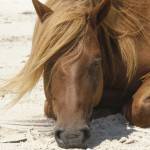Effects of Vitamin E Supplementation and Implications for Treatment of Neurologic Disease

Several equine neurologic diseases have been associated with vitamin E deficiency or improve with vitamin E supplementation; these include equine motor neuron disease (EMND), equine degenerative myelopathy (EDM), and neuroaxonal dystrophy (NAD). Additionally, many veterinarians prescribe supplementary vitamin E for the treatment of other equine central nervous system diseases or trauma. The recommended dose of micellized natural vitamin E (water-soluble d-alpha-tocopherol) for horses with neurologic disease is usually 5,000-10,000 IU by mouth every 24 hours.
Researchers at the University of California at Davis have performed studies investigating the effects of vitamin E supplementation on serum and cerebrospinal fluid (CSF) concentrations in horses. Cerebrospinal fluid is produced in the lateral ventricles of the brain, and it surrounds the brain and spinal cord.
In the first study, horses were supplemented with either 1,000 IU or 10,000 IU of water-soluble, natural, micellized vitamin E for 10 days. Serum vitamin E concentrations were measured throughout the study, and a spinal tap was performed on the first and tenth day. Serum vitamin E concentrations significantly increased with either dose of vitamin E. Vitamin E concentrations in CSF were highest in horses that received 10,000 IU of supplemental vitamin E, but the difference in CSF alpha-tocopherol was not statistically significant between the two doses. The results of the study showed that supplemental vitamin E, at either dose, could raise CSF alpha-tocopherol concentrations by 1.3 to 3.4 times. This study also confirmed that a micellized natural form of vitamin E could penetrate the blood-brain barrier and enter the CSF.
In a second study, horses were supplemented with either 5,000 or 10,000 IU of water-soluble natural micellized vitamin E or 10,000 IU of synthetic vitamin E (dl-alpha-tocopherol) for 14 days. Serum vitamin E concentrations were measured throughout the study, and a spinal tap was performed on the first and fourteenth day. Serum and CSF vitamin E concentrations were significantly correlated. Natural vitamin E was better absorbed and passed through the blood-brain barrier more effectively than synthetic vitamin E. The results of this study showed that natural micellized vitamin E was more bioavailable (able to be absorbed and utilized by the horse) and resulted in greater serum and CSF vitamin E concentrations.
Horses suffering from neurologic disease may require more vitamin E than normal, healthy horses. Vitamin E supplementation and increased CSF vitamin E concentration can enhance the antioxidant defenses of the central nervous system when neurologic disease is present. Water-soluble, natural, micellized vitamin E is recommended over synthetic vitamin E for the treatment of neurologic disease to maintain normal neurologic function and to reduce inflammation and degeneration of the central nervous system.
Summarized from: Kane, E., R.L. Stuart, and N. Pusterla. 2010. Influence of source and quantity of supplemental vitamin E on equine serum and cerebrospinal fluid α-tocopherol and its implication for neurologic diseases. In: Proc. American Association of Equine Practitioners 56:343-347.








